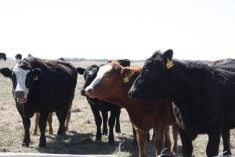This cattle market information is selected from the weekly report from Canfax, a division of the Canadian Cattlemen’s Association. More market information, analysis and statistics are available by becoming a Canfax subscriber by calling 403-275-5110 or at www.canfax.ca.
Protest affects beef chain
Beef supply chain disruptions plagued the cattle complex last week and two major beef plants opted out of the cash market. Without bids, few cattle traded.
Read Also

Flax sector sees omega-3 opportunity
SASKATOON — A global shortage of omega-3 oils could be an opportunity for the flax sector, says an industry official….
Light dressed trade was reported from $260-$270 per hundredweight delivered and weighted average heifer prices slipped more than $2 per cwt. lower than the previous week. Convoy protest disruptions affected everything from beef distribution to live cattle movement and feedgrain shipments.
Western Canadian fed slaughter for the week ending Jan. 29 surged eight percent higher than the previous week to 45,964 head while eastern fed slaughter dipped six percent lower to 10,908 head. Year to date, western Canadian fed slaughter was two percent below a year ago, totalling 161,022 head.
Canadian fed cattle/cow exports to the United States for the week ending Jan. 22 eased 15 percent lower than the previous week to 9,977 head.
Ontario saw light sale volumes last week with prices fully steady with the previous week from $289-$290 per cwt. delivered. Weighted average Ontario steer prices continued to be range bound at $173.10 per cwt. for the sixth straight week.
In the U.S., light to moderate trade was reported in the north with live prices US$1-$4 per cwt. higher than the previous week, from $138-$141. Most northern dressed sales were $2-$5 per cwt. higher from $220-$224 per cwt. delivered.
Cows trend lower
Butcher cows traded $1-$2 per cwt. lower through commercial auctions last week. D2s averaged $77.50 and D3s averaged $67.50 per cwt.
Competition on ring cows was weak with one major packer not buying. Logistics issues and full reefer units of beef sitting idle and not making it to their destination weighed on slaughter cattle prices.
According to the Canadian Meat Council, there were 150 trucks sitting, unable to cross the border early last week due to the blockades. There are reports that one packer is operating one shift per day.
Since the start of the year, Alberta cow prices have been at a $7-$10 per cwt. discount against the U.S. utility cow market. Slaughter bull marketings have been light. For January, bull exports were down 43 percent versus last year while Canadian bull slaughter is down 51 percent.
Ontario cow prices were $2.25 per cwt. higher and were at a slight premium to the Alberta market. Ontario cow prices are at the highest point since late September.
Feeder prices under pressure
Alberta calf and feeder prices were pressured last week. The only class of cattle trading lower than the five-year average was 400-500 pound steers and heifers.
The Manitoba market has some of the highest prices in Canada. Manitoba steer calves weighing 500-700 lb. traded at a $3-$4 per cwt. premium over Alberta and Saskatchewan steers.
Since the start of the year, Alberta steers and heifers heavier than 900 lb. have seen prices drop by $8- $11 per cwt. Seasonally heavier weight feeder prices usually decline from January to February and have a strong tendency to bottom in April.
Since the start of January, Alberta steers heavier than 900 lb. have seen a price decline of four percent. An historical price decline of 15 percent would put prices on track to bottom in the $160 per cwt. area. Prices are not expected to decline this much.
Alberta 550 lb. steer prices have traded mostly sideways in the past three weeks, ranging from $223-$226 per cwt. On a cash-to-cash basis, calf prices are at a $15 per cwt. discount compared to the U.S. market.
For the week ending Jan. 22, Canadian feeder cattle exports to the U.S. totalled 4,790 head, 198 percent higher than last year. For the second half of January this is the largest export volume since 2015.
In the bred cattle market, supply is outpacing demand. Last week there were more smaller lots of 15 to 30 cows on offer and few herd dispersals. Bred cows traded $1,050- $1,850 per head, averaging $1,350. Bred heifers traded from $1,300-$2,025 per head, averaging $1,600, while bred cow and heifer prices are $500 per head lower than last year.
Cut-outs lower
In U.S. beef trade, cut-out values continued to fall. Choice averaged US$281.46 and Select averaged $276.47 per cwt. Increased beef production and seasonally soft February demand are expected to pressure prices lower.














